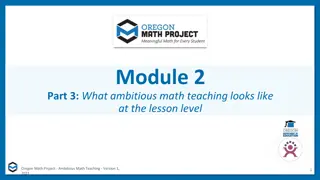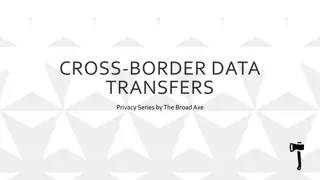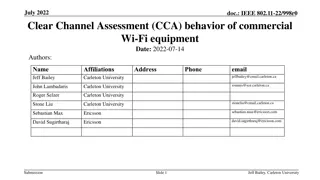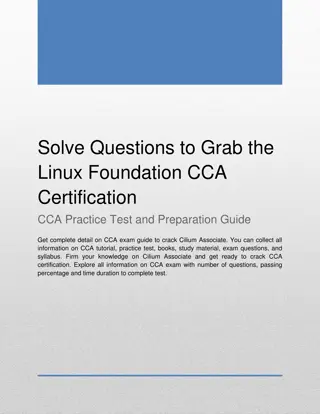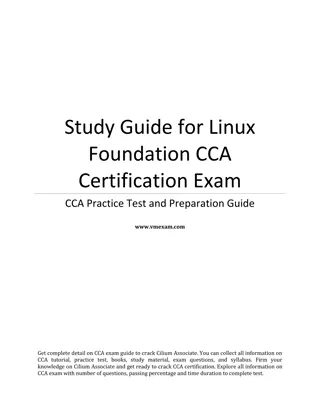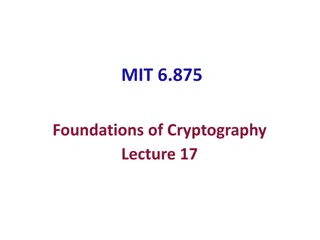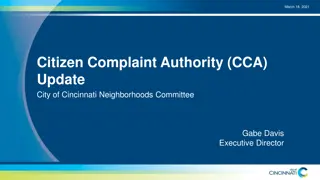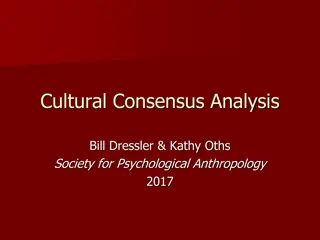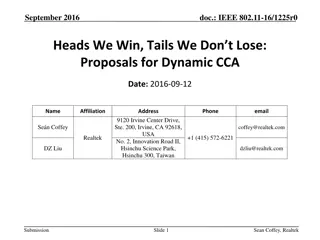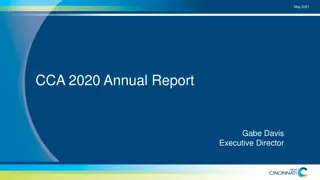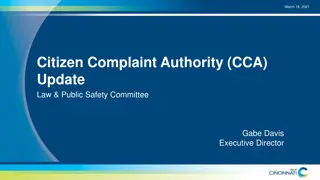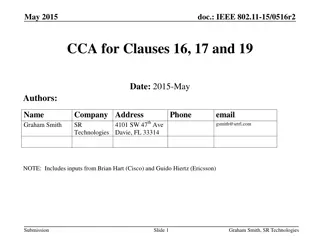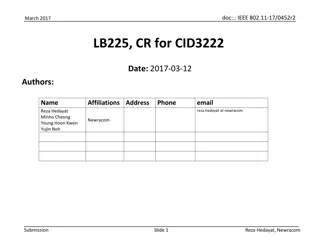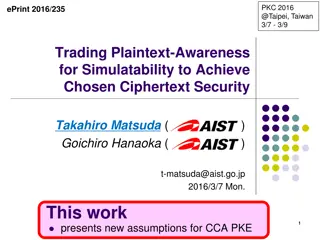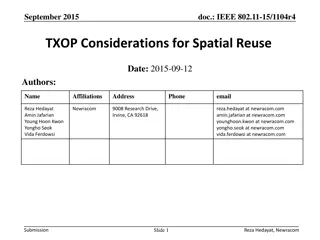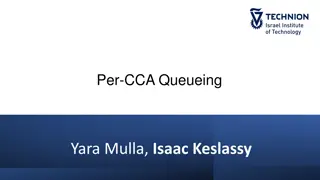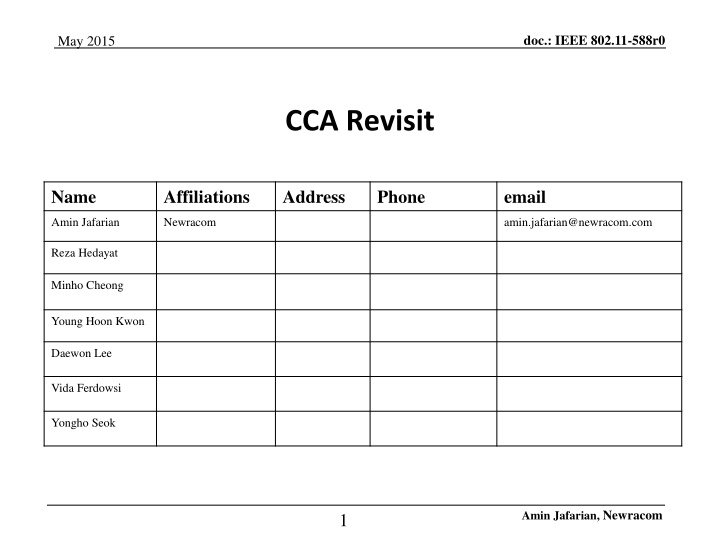
Performance Analysis and Optimization of IEEE 802.11 CCA Mechanism
Explore the insights from IEEE 802.11-588r0 document on the performance analysis and improvements of the Clear Channel Assessment (CCA) mechanism. Learn about the impact of spatial reuse, CCA threshold levels, and the probability of communication in crowded network scenarios. Discover how adjustments in CCA parameters can enhance network efficiency and reduce interference.
Download Presentation

Please find below an Image/Link to download the presentation.
The content on the website is provided AS IS for your information and personal use only. It may not be sold, licensed, or shared on other websites without obtaining consent from the author. If you encounter any issues during the download, it is possible that the publisher has removed the file from their server.
You are allowed to download the files provided on this website for personal or commercial use, subject to the condition that they are used lawfully. All files are the property of their respective owners.
The content on the website is provided AS IS for your information and personal use only. It may not be sold, licensed, or shared on other websites without obtaining consent from the author.
E N D
Presentation Transcript
doc.: IEEE 802.11-588r0 May 2015 CCA Revisit Name Affiliations Address Phone email Amin Jafarian Newracom amin.jafarian@newracom.com Reza Hedayat Minho Cheong Young Hoon Kwon Daewon Lee Vida Ferdowsi Yongho Seok Amin Jafarian, Newracom 1
doc.: IEEE 802.11-588r0 Percentage of spatial reuse that CCA prevented CCA Performance analysis In the last meeting, we showed a new performance analysis for CCA: Measures the probability that a new pair of STA could communicate while the CCA did not allow it Note: The lower the number, the better the performance of the CCA is 1 We also showed two different type of curves: 1. Secondary pair is allowed to exist even if it perturbs the primary transmission (as long as the MCS0 is attainable at the primary pair) 2. Secondary pair is not allowed to has any effect on the primary transmission We concluded that this probability is low enough if we increase the CCA threshold to -72dbm Percentage of spatial reuse that CCA prevented 2 Normalized distance between primary nodes Amin Jafarian, Newracom 2
doc.: IEEE 802.11-588r0 What if there are multiple Secondary STAs? In a crowded network it is very likely that there are multiple BSS around the BSS that sets the CCA In each BSS, there are multiple STAs that the BSS AP could potentially communicate with during the CCA What is the probability that at least one AP among all the neighbor BSS could communicates with at least one of its STAs, but the CCA did not permit? We will simulate this for two CCA levels as before Amin Jafarian, Newracom 3
doc.: IEEE 802.11-588r0 4 BSS each with 5 or 10 STAs 1. Green curve: x% of the time, there could be another secondary pair among OBSS that might have perturbed the primary transmission, (given that both could coexist together with at least MCS0), but the CCA did not allow Red Curve: x% of the time, there could be another secondary pair among OBSS without effecting the primary transmission at all, but the CCA did not allow Percentage of spatial reuse that CCA prevented 2. Normalized distance between primary nodes Amin Jafarian, Newracom 4
doc.: IEEE 802.11-588r0 Results are dramatic for CCA=-82dBm Percentage of spatial reuse that CCA prevented Normalized distance between primary nodes Amin Jafarian, Newracom 5
doc.: IEEE 802.11-588r0 How to use the CCA limitations? More aggressive CCA level is not really a solution, as we can see, even - 72dbm CCA level for 4 BSS with 10 STAs wastes 60% of the OBSS secondary transmission coexistence. The only way to utilize this situation is by allowing the OBSS STAs to transmit over the existing CCA guaranteeing some criteria For example making sure that some power constraint is satisfied at the primary receiver Amin Jafarian, Newracom 6
doc.: IEEE 802.11-588r0 Summary While more aggressive CCA threshold (for example -72dBm) does help increasing the medium utilization significantly, it does not help in crowded network In a network of 40 STAs, there is a chance of >50% that some other pair of STAs could share the medium with the CCA holder but the CCA prevents that (this is the case when CCA threshold is -72dbm). For CCA threshold of -82db, it is more than 95% chance STAs should be allowed to ignore the CCA if they can guarantee some conditions (for example max interference at the primary receiver) Amin Jafarian, Newracom 7
doc.: IEEE 802.11-588r0 Straw Polls 1. Do you agree that: A STA is allowed to transmit even if the channel is busy if some specific condition is met. Y/N/A: 2. Do you agree that: One instant of the above condition is limiting the maximum amount of interference caused by the secondary transmission on the primary receiver. Y/N/A: Amin Jafarian, Newracom 8
doc.: IEEE 802.11-588r0 Back Up slides From 15/318r1 Amin Jafarian, Newracom 9
doc.: IEEE 802.11-588r0 Evaluate CCA protocol Conventional way to evaluate CCA protocols 1. Consider a few specific scenarios Fix location of STAs/APs in each scenario 2. Compute the average medium efficiency gain/loss due to the proposed CCA per scenario and compare it with the baseline CCA. Potential Issues: 1. In each Scenario, the evaluation results can be extremely STA locations dependent There might be many more locations that the proposed CCA does not provide any gain There might be many locations that the gain is higher What is a good definition for gain can be debatable and the result can totally change depends on definition of the gain Weighted sum-rate (not fair to the CCA originator) Maximum achievable rate (not fair to the CCA originator) 2. Amin Jafarian, Newracom 10
doc.: IEEE 802.11-588r0 Proposed Evaluation Criteria To address the previous issues, we propose the following way to evaluate CCA: 1. For an specific scenario, and the proposed CCA, consider many joint locations for all the STAs in the network 2. For each of the locations, compute the event if a simultaneous transmission was possible but the proposed CCA did not allow 3. Compute the percentage number of joint locations (average cases) that #2 was satisfied 1. The lower the number is, the better the proposed CCA performed 2. The same thing can be done for the current CCA regime and we can compare the result to see how much gain the proposal provided The simultaneous transmission could have no additional conditions: Gain definition 1: both transmissions were possible by at least the lowest MCS Note that this provides an upper bound on the performance of the CCA. But it is not fair for the CCA originator Or under the condition that the secondary transmission does not hurt the CCA originator s transmissions Gain definition 2: the secondary transmission was possible with at least the lowest MCS while the original transmission does not change its MCS level Note 1: that this is the best performance that one can expect from a CCA regime and what we believe is the correct definition of medium efficiency and fairness in this scenario. Note 2: while we believe it is very difficult to propose a CCA regime to accomplish this, in our examples, by providing some side information to the transmitters, we will put a figure on this gain. Amin Jafarian, Newracom 11
doc.: IEEE 802.11-588r0 Comparing two approaches While conventional approach can provide us with the maximum and minimum gain in an specific CCA regime, the new approach will provide a figure of how the CCA regime works in an average deployment. Note that most of the users will not optimize the location of their APs and most of the STAs are moving around, so and average gain (average over the joint possible locations of all the STAs) should be a better metric to measure proposed CCA performance. We propose to Compute the percentage number of joint locations that two simultaneous transmission (by either allowing hurting or not allowing hurting the original transmitter) was possible but not allowed under the proposed CCA. This allows us to find a lower and upper bound on the performance of CCA regime instead of focusing on an specific efficiency metric. Amin Jafarian, Newracom 12
doc.: IEEE 802.11-588r0 Simple Scenario We will show a few example of two different CCA regimes under a very simple scenario and assumptions: We consider a very simple outdoor scenario, no shadowing, no multipath Two BSS: Primary: This is the CCA originator, we assume the STA started the NAV is the AP in the primary BSS but the same idea goes through if it is a non-AP STA Secondary: This is the BSS close to the primary CCA The transmitter of the secondary BSS is located in the area that is blocked by the existing CCA rules (received power at the transmitter of secondary is greater than the proposed CCA threshold) We will calculate the percentage of scenarios (locations) under which there could be a secondary transmission Because of symmetry we will fix the location of primary pair and change the secondary pair locations We find the percentage of locations that the secondary transmission could exist but it is not allowed as a function of normalized distance of Primary TX and RX (normalized such that the maximum distance for MCS0 being 1). We modify the TX powers at each STA and plot the result for each set of TX power. For MCS calculations, we used a simple mapping of received SINR to MCS at each receiver. We considered RX sensitivity =-88dbm, and the minimum SINR=4db that maps to MCS0. Data Packet Assumptions: Primary Transmitter has a very long packet in the air (more than the duration needed for the secondary packet to be transmitted) Amin Jafarian, Newracom 13
doc.: IEEE 802.11-588r0 Step1: Fixed the Location of Primary Pairs at distance r (start with very small r) Primary Receiver RX sensitivity Range Location of Primary Receiver Location of Primary Transmitte r Primary Transmitter Range for TX power=15dbm RX sensitivity=-88 dbm Amin Jafarian, Newracom 14
doc.: IEEE 802.11-588r0 CCA Coverage CCA coverage of the ongoing transmission Amin Jafarian, Newracom 15
doc.: IEEE 802.11-588r0 Step 2: Through Secondary TX and RX Secondary Transmitter Range for TX power=15dbm RX sensitivity=-85 dbm Location of secondary Transmitter NOTE: it is within CCA threshold of ongoing tranmission Amin Jafarian, Newracom 16
doc.: IEEE 802.11-588r0 Step 3: Compute if two simultaneous transmission is possible Secondary Receiver Range for TX power=15dbm RX sensitivity=-85 dbm Location of secondary receiver NOTE: it is within the RX range of secondary transmitter Amin Jafarian, Newracom 17
doc.: IEEE 802.11-588r0 Final Steps Step 4: Repeat step 2 and 3 many times At the end find the percentage of cases that two simultaneous transmission was possible Step 5: Change the normalized distance of primary pair to r+delta Redo the computations Step 6: Plot the percentage of cases with respect to distance r Amin Jafarian, Newracom 18
doc.: IEEE 802.11-588r0 CCA Regimes Four CCA regimes are considered: CCA threshold -72dbm 1. Fixed power: Secondary STAs are not allowed to change their TX power 2. Dynamic Power: Secondary STAs are provided with the channel knowledge so that they can compute the optimal transmit power that enables them to communicate without causing much interference to the primary pair if possible at all Note that this provides the best possible performance one can expect from dynamic CCA. The goal of this presentation is no to address how this information is provided. It is more along the direction of how much this best information can improve CCA regime CCA threshold -82dbm 3. Fixed Power 4. Dynamic Power Amin Jafarian, Newracom 19
doc.: IEEE 802.11-588r0 Results I (MAX TX powers= 15, 15, 15, 15) Percentage of spatial reuse that CCA prevented Under Gain definition 1 Under Gain definition 2 Percentage of spatial reuse that CCA prevented Normalized distance between primary nodes Normalized distance between primary nodes Amin Jafarian, Newracom 20
doc.: IEEE 802.11-588r0 Results I (TX powers= 15, 15, 5, 5) Percentage of spatial reuse that CCA prevented Percentage of spatial reuse that CCA prevented Under Gain definition 2 Under Gain definition 1 Normalized distance between primary nodes Normalized distance between primary nodes Amin Jafarian, Newracom 21
doc.: IEEE 802.11-588r0 Interpretation In these scenarios dynamic CCA is not needed: CCA threshold of -72dbm provides very good result, in fact it is less than 5% of locations that the secondary pair could utilize the medium and CCA prevents that so is there any motivation to propose a more complicated CCA regime for all the STA just to achieve that 5% of locations? This is specially the case where the secondary Transmitter is a non-AP STA. Amin Jafarian, Newracom 22

